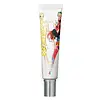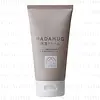What's inside
What's inside
 Key Ingredients
Key Ingredients

 Benefits
Benefits

 Concerns
Concerns

 Ingredients Side-by-side
Ingredients Side-by-side

Water
Skin ConditioningButylene Glycol
HumectantEthylhexyl Methoxycinnamate
UV AbsorberDiethylhexyl Succinate
EmollientDiethylamino Hydroxybenzoyl Hexyl Benzoate
UV FilterPentylene Glycol
Skin ConditioningVp/Eicosene Copolymer
Honey
HumectantSodium Hyaluronate
HumectantHydrolyzed Collagen
EmollientHydrolyzed Elastin
EmollientHydrolyzed Mango Juice Extract
Skin ConditioningHydrolyzed Garcinia Mangostana Fruit Extract
Skin ConditioningHydrolyzed Annona Cherimola Fruit Extract
AntioxidantOak Root Extract
Skin ConditioningZea Mays Leaf Extract
Skin ConditioningCoffea Arabica Seed Extract
MaskingCeramide NP
Skin ConditioningRetinol
Skin ConditioningAcetyl Glucosamine
Skin ConditioningOryza Sativa Seed Oil
Skin ConditioningCassia Senna Leaf Extract
Skin ConditioningActinidia Chinensis Fruit Extract
EmollientYeast Extract
Skin ConditioningAlteromonas Ferment Extract
Skin ConditioningCerium Oxide
Vitis Vinifera Seed Extract
AntimicrobialCaffeine
Skin ConditioningCarnitine
CleansingLactic Acid
BufferingGlucosyl Hesperidin
HumectantChlorella Vulgaris Extract
Skin ConditioningKunzea Pomifera Fruit Extract
Skin ConditioningChrysanthemum Indicum Extract
AntioxidantZea Mays Oil
EmulsifyingPantetheine Sulfonate
Skin ConditioningMicrocrystalline Cellulose
AbsorbentMaltodextrin
AbsorbentTocopherol
AntioxidantPlatinum
AntimicrobialSorbitol
HumectantGlycerin
HumectantSodium Ascorbyl Phosphate
AntioxidantMenthol
MaskingEthylhexylglycerin
Skin ConditioningGlyceryl Stearate
EmollientSilica
AbrasiveTitanium Dioxide
Cosmetic ColorantOctocrylene
UV AbsorberMethyl Methacrylate Crosspolymer
Bis-Ethylhexyloxyphenol Methoxyphenyl Triazine
Skin ConditioningHydroxyethyl Acrylate/Sodium Acryloyldimethyl Taurate Copolymer
Emulsion StabilisingAcrylates/C10-30 Alkyl Acrylate Crosspolymer
Emulsion StabilisingAmmonium Acryloyldimethyltaurate/Vp Copolymer
T-Butyl Alcohol
PerfumingSodium Hydroxide
BufferingPentetic Acid
CI 77492
Cosmetic ColorantAlumina
AbrasivePEG-60 Almond Glycerides
EmulsifyingCapric Acid
CleansingCetyl Hydroxyethylcellulose
Emulsion StabilisingAlcohol Denat.
AntimicrobialPolysorbate 60
EmulsifyingMica
Cosmetic ColorantPhenoxyethanol
PreservativeDiamond Powder
AbrasiveParfum
MaskingWater, Butylene Glycol, Ethylhexyl Methoxycinnamate, Diethylhexyl Succinate, Diethylamino Hydroxybenzoyl Hexyl Benzoate, Pentylene Glycol, Vp/Eicosene Copolymer, Honey, Sodium Hyaluronate, Hydrolyzed Collagen, Hydrolyzed Elastin, Hydrolyzed Mango Juice Extract, Hydrolyzed Garcinia Mangostana Fruit Extract, Hydrolyzed Annona Cherimola Fruit Extract, Oak Root Extract, Zea Mays Leaf Extract, Coffea Arabica Seed Extract, Ceramide NP, Retinol, Acetyl Glucosamine, Oryza Sativa Seed Oil, Cassia Senna Leaf Extract, Actinidia Chinensis Fruit Extract, Yeast Extract, Alteromonas Ferment Extract, Cerium Oxide, Vitis Vinifera Seed Extract, Caffeine, Carnitine, Lactic Acid, Glucosyl Hesperidin, Chlorella Vulgaris Extract, Kunzea Pomifera Fruit Extract, Chrysanthemum Indicum Extract, Zea Mays Oil, Pantetheine Sulfonate, Microcrystalline Cellulose, Maltodextrin, Tocopherol, Platinum, Sorbitol, Glycerin, Sodium Ascorbyl Phosphate, Menthol, Ethylhexylglycerin, Glyceryl Stearate, Silica, Titanium Dioxide, Octocrylene, Methyl Methacrylate Crosspolymer, Bis-Ethylhexyloxyphenol Methoxyphenyl Triazine, Hydroxyethyl Acrylate/Sodium Acryloyldimethyl Taurate Copolymer, Acrylates/C10-30 Alkyl Acrylate Crosspolymer, Ammonium Acryloyldimethyltaurate/Vp Copolymer, T-Butyl Alcohol, Sodium Hydroxide, Pentetic Acid, CI 77492, Alumina, PEG-60 Almond Glycerides, Capric Acid, Cetyl Hydroxyethylcellulose, Alcohol Denat., Polysorbate 60, Mica, Phenoxyethanol, Diamond Powder, Parfum
Water
Skin ConditioningPropanediol
SolventSimmondsia Chinensis Seed Oil
EmollientGlycerin
HumectantButyrospermum Parkii Butter
Skin ConditioningBehenyl Alcohol
EmollientSqualane
EmollientBis-Behenyl/Isostearyl/Phytosteryl Dimer Dilinoleyl Dimer Dilinoleate
EmollientPinus Pinaster Leaf Extract
Skin ConditioningTrehalose
Humectant1,2-Hexanediol
Skin ConditioningStearic Acid
CleansingBifida Polysaccharide
HumectantButylene Glycol
HumectantTocopherol
AntioxidantAmmonium Acryloyldimethyltaurate/Vp Copolymer
T-Butyl Alcohol
PerfumingWater, Propanediol, Simmondsia Chinensis Seed Oil, Glycerin, Butyrospermum Parkii Butter, Behenyl Alcohol, Squalane, Bis-Behenyl/Isostearyl/Phytosteryl Dimer Dilinoleyl Dimer Dilinoleate, Pinus Pinaster Leaf Extract, Trehalose, 1,2-Hexanediol, Stearic Acid, Bifida Polysaccharide, Butylene Glycol, Tocopherol, Ammonium Acryloyldimethyltaurate/Vp Copolymer, T-Butyl Alcohol
Alternatives
Ingredients Explained
These ingredients are found in both products.
Ingredients higher up in an ingredient list are typically present in a larger amount.
Ammonium Acryloyldimethyltaurate/Vp Copolymer (let's call it AAVC for short) is a synthetically created polymer. It's used as a film-forming agent and used to thicken the consistency of products.
AAVC is able to increase the consistency and viscosity of products due to its large molecule size. It also prevents ingredients from separating.
Butylene Glycol (or BG) is used within cosmetic products for a few different reasons:
Overall, Butylene Glycol is a safe and well-rounded ingredient that works well with other ingredients.
Though this ingredient works well with most skin types, some people with sensitive skin may experience a reaction such as allergic rashes, closed comedones, or itchiness.
Learn more about Butylene GlycolGlycerin is already naturally found in your skin. It helps moisturize and protect your skin.
A study from 2016 found glycerin to be more effective as a humectant than AHAs and hyaluronic acid.
As a humectant, it helps the skin stay hydrated by pulling moisture to your skin. The low molecular weight of glycerin allows it to pull moisture into the deeper layers of your skin.
Hydrated skin improves your skin barrier; Your skin barrier helps protect against irritants and bacteria.
Glycerin has also been found to have antimicrobial and antiviral properties. Due to these properties, glycerin is often used in wound and burn treatments.
In cosmetics, glycerin is usually derived from plants such as soybean or palm. However, it can also be sourced from animals, such as tallow or animal fat.
This ingredient is organic, colorless, odorless, and non-toxic.
Glycerin is the name for this ingredient in American English. British English uses Glycerol/Glycerine.
Learn more about GlycerinT-Butyl Alcohol it is most commonly used as a solvent.
At room temperature, T-Butyl Alcohol melts and has a similar smell to camphor.
This ingredient is derived from isobutane. It is the simplest form of a tertiary alcohol. Due to its chemical structure, it is more resistant to oxidation.
Some sources online claim T-Butyl Alcohol is a fatty alcohol. However, it is not considered one due to its chemical structure.
Learn more about T-Butyl AlcoholTocopherol (also known as Vitamin E) is a common antioxidant used to help protect the skin from free-radicals and strengthen the skin barrier. It's also fat soluble - this means our skin is great at absorbing it.
Vitamin E also helps keep your natural skin lipids healthy. Your lipid skin barrier naturally consists of lipids, ceramides, and fatty acids. Vitamin E offers extra protection for your skin’s lipid barrier, keeping your skin healthy and nourished.
Another benefit is a bit of UV protection. Vitamin E helps reduce the damage caused by UVB rays. (It should not replace your sunscreen). Combining it with Vitamin C can decrease sunburned cells and hyperpigmentation after UV exposure.
You might have noticed Vitamin E + C often paired together. This is because it is great at stabilizing Vitamin C. Using the two together helps increase the effectiveness of both ingredients.
There are often claims that Vitamin E can reduce/prevent scarring, but these claims haven't been confirmed by scientific research.
Learn more about TocopherolWater. It's the most common cosmetic ingredient of all. You'll usually see it at the top of ingredient lists, meaning that it makes up the largest part of the product.
So why is it so popular? Water most often acts as a solvent - this means that it helps dissolve other ingredients into the formulation.
You'll also recognize water as that liquid we all need to stay alive. If you see this, drink a glass of water. Stay hydrated!
Learn more about Water